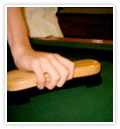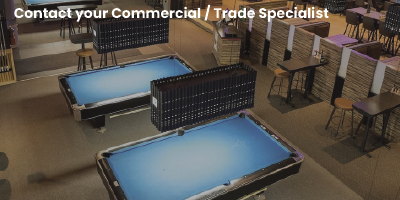Billiard Table Maintenance
John Roufas2021-12-28T17:43:49-04:00Billiard Table Maintenance

A billiard table is an expensive investment. You’ll want to take care of it so you can get the longest possible life from the cloth and be able to pass the table down through the generations. We have assembled the definitive knowledge base of pool table care tips and tricks. A few easy steps can keep table looking and playing as good as new for years and years to come.
Cloth Care
Cleaning the cloth on your table is perhaps the most important and the most frequent task necessary to maintain your table’s high performance. As billiard cloth is the most contacted and exposed part of your table, it often becomes the dirtiest. Keeping the cloth free of dust, chalk, and any other foreign material is important. Material left on billiard cloth not only esthetically unpleasing, it can also become distracting to a player during a shot or even affect the course of a ball in play and can cause the cloth to wear more quickly.
Brushing
Brushing your table cloth is the most recommended technique for cleaning billiard cloth, as it is the least invasive and manages to remove the majority of material. The type of brush used should have either nylon or horse hair bristle. The length of the brush can range from nine to twelve inches, a larger brush recommended for larger tables, as they get the job done faster. A person should start brushing from the end of the table that has the “baulk” line or break line and the name plate, which is most commonly referred to as the “head” of the table. Brushing should be in one direction only, from head to the “foot” of the table. This is most important when dealing with snooker cloth. Snooker cloth has what is called “nap”. Nap is a term used to denote the direction of a cloths weave. Balls traveling against the nap will move differently then traveling with the nap. Pool cloth is non-directional, hence has no nap. It is still wise to brush pool cloth in one direction, as it puts the least amount of stress on the cloth, stretching the cloth in only one direction. It is also the most efficient. The amount of force applied to the brush should also be regulated to prevent the cloth from stretching too much. Use only as much pressure as required for all the bristles to make contact with the cloth, no more, no less. We recommend that a table’s cloth should be brushed after every ten hours of play or at minimum once a week. If the table is left uncovered, more frequent brushing may be required.
Lint Brushes
Although this is a very effective way to remove material from cloth, as it does not pull on the cloth significantly and gets a lot of the harder to reach particles, it is not a recommended practice. Frequent brushing and the occasional vacuuming are just as effective, and not nearly as costly.
Does the table utilize the “Super Speed” anchoring system?
Only the “Super Speed” method ensures that the rails are fastened securely to the slate. This ultimate link between rail and slate minimizes vibrations and guarantees quiet, lively rebound and playability. Professional “Masterspeed” rubber cushions provide true rebound and maximum accuracy.
Vacuuming
Vacuuming a table, if done with care, is an excellent way to remove stubborn dust, chalk, and pet dander from a cloth, even pulling debris resting on the slate through the cloth. This should be done in one direction, just like brushing. A brush attachment must always be used, never straight suction or rotating bristles, as these will pull on and stretch the cloth. This should only be done every few months, any more is not necessary, as it takes that long for there to be any significant build up of material under and in the cloth.
Ironing
This is only recommended on cloth snooker cloth with a nap. This is a great method for improving a stubborn nap, allowing the fibers to flatten, after being untangled from a good brushing. Only a special dry iron can be used, and should once more, be done in one direction, from head to foot. Again, this is only recommended for snooker cloth, and should only be performed by an experienced individual, as a mistake can be quite costly.
Table Covers
A very simple method for maintaining a clean cloth is by just keeping it covered. Whether a plastic, nylon, or naugahyde cover is used or a basic bed sheet is draped over the table, they all prevent dust and dander from settling on the cloth. Thicker covers such as naugahyde give added protection not only to the cloth, but to the rails as well. This is especially important if anything is to be placed on top of the table, such as a table tennis conversion top, and is highly recommended if the table is to be exposed to cats that have not been de-clawed. Besides dust and animals, sunlight is the next greatest enemy of billiard cloth. If at all possible, a table should not be placed in direct sunlight. Ultra violet radiation from the Sun and from fluorescent light bulbs will fade the cloth over time, and the table should be covered at all times, when not in use.
Pilling
Pilling is the term used for the little fuzz balls found on billiard cloth. This occurs mainly on newer cloth or cloth with a blended wool and nylon make-up, and does going away after time, usually by frequent brushing. This does affect ball play on a table, but it is negligible. It is more often just viewed as unpleasant to look at. Worsted wool cloth does not encounter piling because all the short strands in this cloth have been removed and a tighter weave used, allowing no fibers to become separated from the cloth. This also results in a faster cloth and allows for much easier brushing.
The Dreaded White Spots
White spots are common and can occur on billiard cloth by two means; miss-cueing and “ball burn”. If a player strikes the cue ball too low, the cue can slip and the tip comes into contact with the billiard cloth. This is called a miss-cue and results in wearing the cloth either by removing some of the fibers or, as a result of friction, burn the cloth. These burn marks can also be a result from harder shots, usually the break. When a cue ball is struck with a significant amount of force, it is pushed along the cloth for a brief moment, at incredible speeds. This creates friction and heats up the cloth. Since cloth is typically a wool and nylon blend, the heat created by the shot can melt some of the nylon. As wool has a higher melting point then nylon, the more wool content a cloth has, the less likely ball burn will occur.
Table Pockets
Pool or snooker table pockets are almost always made from leather. Those that are not are typically commercial style plastic drop pockets that require no maintenance at all. Leather pockets react just like any other product made from leather, they can dry out and crack. Applying leather conditioning products to the external pocket, which includes everything but the basket, can prevent this. One should be careful not to come into contact with the tables cloth with any of the product used to condition the pocket. This is not a frequent requirement and should be performed once every six months, although it may be recommended more frequently in dryer climates.
Wood
A table’s external wood parts should be treated just as any good quality piece of furniture. They are best cleaned with a dampened soft cloth followed by a soft dry cloth. Occasionally a good quality furniture polished can be used on the rails, rail apron, table apron, and legs of a table, to remove any dirt and oil from the woods surface. This material is left behind by our contact with the table, and the more frequently the table is played upon, the more frequently in should be cleaned. Polish should be sprayed on a paper towel or cleaning shammy, not directly on the rail, as it may come into contact with the cloth.
| General |
Contact with Table
Leaning heavily, standing, sitting, bumping, or lifting the table can have a detrimental effect. Any pressure on the table’s playing surface will put pressure on the seams between the slate. This slate is sealed upon installation and any pressure can crack these seams. A cracked seam can be felt through the cloth and will not only effect the direction of a ball in play, but will also wear the cloth from underneath. Long or difficult shots should be assisted by a bridge or rest, a player should never sit on a table to make a shot. If an owner requires a table to be moved, they should employ a certified billiard mechanic to prevent any damage being done to the table. Not only can any of the above damage the table, it will most certainly make the table un-level. An un-level table is very difficult to play on, as the balls do not react as expected. If a table becomes un-level, by whatever means, an owner should contact a certified billiard mechanic. Leveling a table is a complex process, and depending on your table can involve either leg leveling or shimming of the slate playing surface or the legs.
Masse and Jump Shots
Nothing looks cooler and is more impressive then jumping the cue ball over another or having the cue ball spin in, out and around the other balls on the table, and nothing is more damaging to the cloth. Even if these types of shots are performed perfectly, which they very rarely are, they are still very damaging to billiard cloth. Usually the shots are not done incorrectly and the cue’s tip comes into contact with the cloth with great force, as to the nature of the attempted shot. This results in wearing holes in the cloth, and in worst cases, ripping a hole right through the cloth. As a table owner, it is recommended to enforce a house rule against these types of shots. It is by far the least expensive way of maintaining your cloth.
Food, Drink, and Smoke
Billiard tables are a great source of entertainment. This usually involves in the consumption of many comfort foods, beverages, and in some cases tobacco. All of this should be kept as far away from a table as possible. Tobacco ash will stain and can burn the cloth. Cigarettes left on the table’s edge will burn the rail, leaving un-repairable marks. Spilt food and drink will also stain a table’s cloth. Condensation rings left by drinks, can damage the cloth or rails, and should not be left to rest on the table. The same goes for any form of foodstuffs. In general, if you or your guests are eating, drinking, or smoking, do so away from your billiard table.



